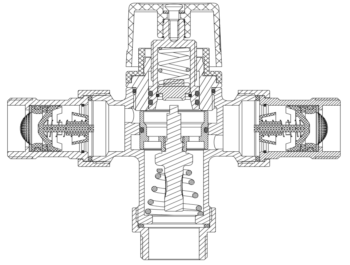How does thermostatic mixing valve do?
2022-10-18.
The Definition and Construction Principle
• Definition and use.
A thermostatic mixing valve (TMV), is a kind of valve that provides continuous, constant temperature mixing water by automatically controlling the ratio of the hot and cold water inlet.
• The structure and working principle.
A thermostatic mixing valve has a thermal element at the mixing outlet, using the characteristics of the thermal element to push the spool in the valve to move and block or open the cold and hot water inlet. When the temperature adjustment knob is set to a certain temperature, no matter how the temperature and pressure of the hot and cold water inlet change, the ratio of hot and cold water entering the outlet will also change. The temperature adjustment knob can be set at any time within the temperature range specified by the product, and the thermostatic mixing valve will automatically keep the water temperature.

Installation Diagram
TMV Manual
Installation requirements and cautions:
• The one marked in red or "H" (Hot) is the hot water inlet. The blue or "C" (Cold) mark is the cold water inlet, "MIX" mark is the mixed water outlet.
• Before installing the mixing valve, the pipe should be thoroughly cleaned to remove the impurities inside. It is recommended to install a filtering device at the cold/hot water inlet end.
• If the hot and cold water pressure is inconsistent, a one-way check valve should be installed in the inlet to prevent cold and hot water cascade.
• If the cold and hot water pressure ratio exceeds 8:1, a pressure-limiting pressure-reducing valve should be installed on the side of the pressure to ensure that the mixed water valve can be adjusted normally.
• In the selection and installation, please ensure that the nominal pressure, mixing water temperature range, and other requirements are within the allowable range.
• Before installation, please pay attention to leaving enough space to facilitate the subsequent maintenance and maintenance. The closer the distance between the mixing valve and the water faucet, the better. A thermostatic mixing valve can be installed horizontally or vertically, the connection between the mixing valve and the pipe needs to be operated by qualified personnel. The thermostatic mixing valve is recommended to be installed together with the interceptor ball valve, filter, and check valve. The interceptor ball valve is used to isolate the mixing valve from the system for easy maintenance of the mixing valve. The filter prevents contaminants from entering the mixing valve and causing damage. The check valve can stop harmful backflow.
The standard of thermostatic mixing valve correspondence
• European standards: NHS D08, EN1111, EN1287, etc.
• Australian Standard: AS4032.2, AS4032.1, etc.
• American Standard: ASSE1070, ASSE1016, ASSE1017 CSA B125.3, etc.
Our company standards in common use:
Due to the application of mixing valves and regional factors, the differences between the standards are mainly reflected in the differences in the relevant technical parameters, and the following is our common standard EN1111, AS4032.1 to carry out the comparison of the below table.
The comparison of EN1111-1999 and AS4032.1-2005 common test items
Categories | Test Items | Test conditions | Judgment Criteria |
EN1111-1999 |
Pressure variation | Hot water temperature: 50--60℃ Cold water temperature: 10--15℃ Cold/hot water supply pressure: 0.31±0.01Mpa Output water flow: 12±0.5L/min Discharge water temperature: 38±1℃ | The cold/hot water pressure is reduced from 0.31Mpa to 0.25Mpa and then recovered from 0.25Mpa to 0.31Mpa respectively, and the deviation of the mixed water temperature and the initial setting temperature does not exceed 2K. |
Security | Hot water temperature: 50--60℃ Cold water temperature: 10--15℃ Cold/hot water supply pressure: 0.31±0.01Mpa Output water flow: 12±0.5L/min Discharge water temperature: 38±1℃ | a. The amount of water collected in the first five seconds ≤ 200ml. If > 200 ml, then the water temperature ≤ 42°C. b. The amount of water collected in the last 30 seconds ≤ 300ml. c. Resume the supply of cold water, stable mixed water temperature deviation ≤ 2K. | |
AS4032.1-2005 |
Pressure variation | Hot water temperature: 65±2℃ Cold water temperature: 15±5℃ Cold / hot water supply pressure: Pc±2%, Ph±2% (0.1Mpa, 0.5Mpa) Output water flow: 12±0.5L/min Discharge water temperature: T. (minimum/maximum temperature) | The cold water pressure is reduced to PcX10%±2%, and then restored to the initial pressure (100→ 90→ 100kpa, 500→ 450→ 500kpa) The deviation of the mixed water temperature and the initial set temperature does not exceed ±3℃ |
Security | Hot water temperature: 65±2℃ Cold water temperature: 15±5℃ Cold / hot water supply pressure: 0.3±0.01Mpa Output water flow: 12±0.5L/min Discharge water temperature: T. (minimum/maximum temperature) | a. After cutting off the cold water, the amount of water collected from the 6th to 66th seconds ≤ 500ml. b. Resume the supply of cold water, the temperature deviation of the mixed water after stabilization and the initial temperature ≤ ± 3 ℃. |





